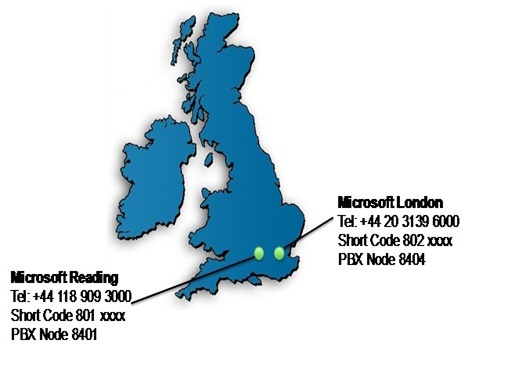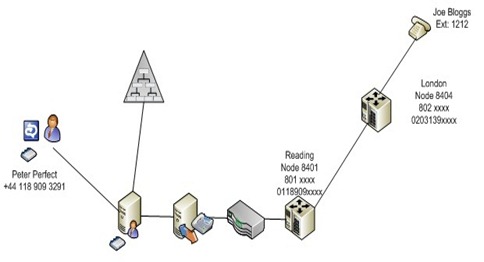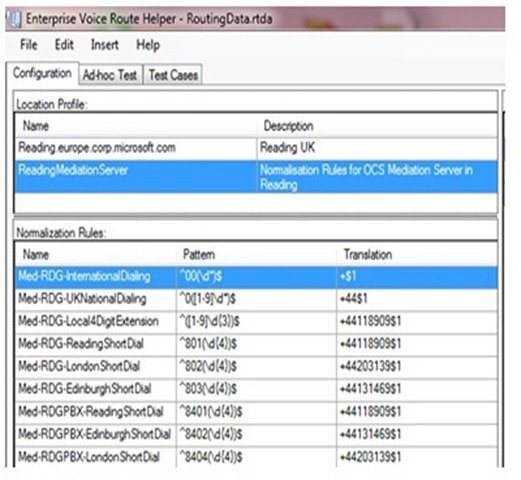Reverse Number Lookup and Dealing with Legacy PBX
Working with customers I have come across a number of scenarios where the caller ID presented from the PBX is not in E164/DID (Direct Inward Dial) format. Some gateways allow for extensive manipulation of the caller ID, some less so. The good news is that in OCS 2007 R2 you can now easily solve the problem and this has also been made available as a hotfix for OCS 2007 R1 (https://support.microsoft.com/kb/954647/en-us) . Below is an explanation of how it works and what you need to put in place.
In a simple scenario, you have 2 sites, each with a PBX. There is in place standard short code site dialing. I have also included the PBX node numbers as I have seen these exposed in some cases.
Now if we take the simple scenario of Peter in Reading on OCS which is connected through a mediation server and a basic gateway to a PBX in Reading. Joe is a user in London connected to a PBX in London.
When Joe calls Peter the following occurs
The call is routed from the London PBX to the Reading PBX and then on to the basic gateway.
The gateway will create a SIP invite message and the “to” address is usually formatted correctly but the “from” address could be in one of several formats depending on your legacy PBX
DID number 442031391212
Short Dial number 8021212
Internal dial number 84041212
If you are fortunate and it is in DID format then the basic gateway can easily add +, as can the mediation server. More likely though you either have the short dial number, or as in this case the internal dial number (using the PBX node number)
You can see from the log from my basic gateway the formatting of the different addresses I have highlighted in red.
---- Outgoing SIP Message to 10.1.10.7:5060 ----
INVITE sip:+441189093291@10.1.10.7;user=phone SIP/2.0
Via: SIP/2.0/TCP 10.1.10.10;branch=z9hG4bKac295994674;alias
Max-Forwards: 70
From : "84041212" <sip:84041212@10.1.10.10> ; tag=1c295989178
To: <sip:+441189093291@10.1.10.7;user=phone>
Call-ID: 29598879711200021026@10.1.10.10
CSeq: 1 INVITE
Contact: <sip:84041212@10.1.10.10;transport=tcp>
Supported: em,100rel,timer,replaces,path,resource-priority
Allow: REGISTER,OPTIONS,INVITE,ACK,CANCEL,BYE,NOTIFY,PRACK,REFER,INFO,SUBSCRIBE,UPDATE
User-Agent: Audiocodes-Sip-Gateway-MP-114 FXS_FXO/v.5.00A.035.003
Content-Type: application/sdp
Content-Length: 258
When the message is received by the mediation server, because the “from” number is not in E164 format it will add its configured location profile to the “from” address as a phone-context which I have highlighted in red in the log below.
TL_INFO(TF_PROTOCOL) [0]0B9C.1004::03/18/2009-13:48:03.831.000010a9 (SIPStack,SIPAdminLog::TraceProtocolRecord:SIPAdminLog.cpp(122))$$begin_record
Instance-Id: 00000134
Direction: incoming
Peer: redmed01.europe.corp.microsoft.com:2503
Message-Type: request
Start-Line: INVITE sip:peter@microsoft.com;opaque=user:epid:jDT7sohH91mi5ocvidTJugAA;gruu SIP/2.0
From: <sip:84041212;phone-context=readingmediationserver@microsoft.com;user=phone>; epid=1460650F33;tag=dedea5f4a2
To: <sip:+441189093291@microsoft.com;user=phone>; epid=7e731b1d1b;tag=03d30514a1
CSeq: 16 INVITE
Call-ID: b7a0659b-57d0-4336-98e8-0725f897415b
MAX-FORWARDS: 70
VIA: SIP/2.0/TLS 10.1.1.7:2503;branch=z9hG4bK42fecdc
ROUTE: <sip:redmed01.europe.corp.microsoft.com:5061;transport=tls;opaque=state:T;lr>
CONTACT: <sip: redmed01.europe.corp.microsoft.com @microsoft.com;gruu;opaque=srvr:MediationServer:kqKefwcAxUeuOkjBv6DxWwAA;grid=92401592ca3b413db9bf01d752fdbf7b>;isGateway
CONTENT-LENGTH: 704
SUPPORTED: replaces
SUPPORTED: ms-safe-transfer
SUPPORTED: gruu-10
SUPPORTED: 100rel
USER-AGENT: RTCC/3.5.0.0 MediationServer
CONTENT-TYPE: application/sdp
Message-Body: v=0
The pool front end server uses the location profile in the phone-context to normalise the number. I would recommend using a different location profile to the one you assign to users as the rules can be slightly different and allows you the flexibility to customise it to your PBX.
It adds a “P-Asserted-Identity” field to the invite message with the normalised number as shown towards the bottom of the invite message below.
TL_INFO(TF_PROTOCOL) [0]0B9C.1004::03/18/2009-13:47:56.380.00000f6e (SIPStack,SIPAdminLog::TraceProtocolRecord:SIPAdminLog.cpp(122))$$begin_record
Instance-Id: 00000124
Direction: outgoing
Peer: 10.1.1.1:3121
Message-Type: request
Start-Line: INVITE sip:10.1.1.1:3121;transport=tls;ms-opaque=29e2f0e8e5;ms-received-cid=800 SIP/2.0
From: <sip:84041212;phone-context=readingmediationserver@microsoft.com;user=phone>; epid=1460650F33;tag=dedea5f4a2
To : <sip:+441189093291@microsoft.com;user=phone>; epid=7e731b1d1b
CSeq: 14 INVITE
Call-ID: b7a0659b-57d0-4336-98e8-0725f897415b
Record-Route:<sip:redmed01.europe.corp.microsoft.com:5061;transport=tls;opaque=state:F:Ci.R800:Ieh.F3iAkjnCzw86ws8Paad7Q-xhoz-dlzMeAcTz0kz9ap5Qzj4gqUobs-iQAA;lr;ms-route-sig=aayPE3zUoe-C6QGmGlfPRG4c_CpiLj4gqUobs-iQAA>;tag=5394737F5C726A52BF0897201BE0E06B
Via: SIP/2.0/TLS 10.1.1.2:5061;branch=z9hG4bK494BEF08.940AE2E3D46C2B3C;branched=TRUE;ms-internal-info="aaJ40wWI6TcWSrM9kHR3RfmIeBWPvj4gqUlmojpgAA"
Proxy-Authentication-Info: Kerberos rspauth="602306092A864886F71201020201011100FFFFFFFF4B108BAF713F56BEA6F3CC8B197124B2", srand="F46844E8", snum="51", opaque="30115551", qop="auth", targetname="sip/dubocs01.europe.corp.microsoft.com", realm="SIP Communications Service"
Max-Forwards: 69
Content-Length: 2492
Via: SIP/2.0/TLS 10.1.1.7:2503;branch=z9hG4bKdb55b847;ms-received-port=2503;ms-received-cid=E00
Contact: <sip: redmed01.europe.corp.microsoft.com @microsoft.com;gruu;opaque=srvr:MediationServer:kqKefwcAxUeuOkjBv6DxWwAA;grid=92401592ca3b413db9bf01d752fdbf7b>;isGateway
Supported: replaces
Supported: ms-safe-transfer
Supported: gruu-10
Supported: 100rel
User-Agent: RTCC/3.5.0.0 MediationServer
Content-Type: multipart/alternative; boundary=uuXBWe9zTOKnsjncYiXRaSzuM0iotixl
Allow: UPDATE
Allow: Ack, Cancel, Bye,Invite,Refer
P-Asserted-Identity: <sip:+442031391212@microsoft.com;user=phone>
History-Info: <sip:peter@microsoft.com>;index=1
Message-Body: --uuXBWe9zTOKnsjncYiXRaSzuM0iotixl
When the invite message is received by the Office Communicator client it uses either the “From” field or the “P-Asserted-Identity” field to match against the address book and local Outlook contacts. The problem here is that the numbers in the address book come from Active Directory and these are usually in the short dial format as they are used by users who are not using OCS enterprise voice.
e.g.
User |
Telephone Number |
SIP Line URI |
Peter Perfect |
801 3291 |
Tel:+441189093291 |
Joe Bloggs |
803 1212 |
|
Ruth Smith |
801 3232 |
For this you need to amend the company normalization rules file (Company_Phone_Number_Normalization_Rules.txt) so that it generates number that can be matched against. In this example for London you would add
##
# 802xxxx +44203139xxxx London
##
802[\s()\-\./]*(\d\d\d\d)
+44203139$1
I would also recommend you add a test input entry
#TestInput: 8021234 TestResult: +442031391234
This enables you to easily test your address book normalization rules using the command line:
Abserver.exe -testPhoneNorm
Which would give output like the following:-
Running 1 normalization rules tests
Test from Company_Phone_Number_Normalization_Rules.txt on line 37
Input: '8021234'
Expected Result: '+442031391234'
Actual Result: '+442031391234'
Test PASSED
Matching Rule in Company_Phone_Number_Normalization_Rules.txt on line 15
^802[\s()\-\./]*(\d\d\d\d)$
You can also output the Address book to a text file to view how your numbers are normalizing e.g.
Abserver.exe /dumpFile “f-0bb5.dabs” c:\absdump.txt
Where f-0bb5.dabs is the latest full address book file. You will see entries similar to the following:-
ContactId {GUID}
Mail joe@microsoft.com
TelephoneNumber 802 1212
TelephoneNumber +442031391212
msRTCSIPPrimaryUserAddress sip:joe@microsoft.com
displayName Joe Bloggs
Sn Bloggs
givenName Joe
Notice that there is an additional telephone number entry with the normalised version of the number. This is the normal telephone number field in Active Directory, not the SIP Line URI.
Summary
To summarise what you need to do is:
· Create location profile for mediation server
· Have a consistent number format for telephone numbers in Active Directory
· Edit Company_Phone_Number_Normalization_Rules.txt file to normalize numbers from Active Directory for the address book.
Posted by Paul Brombley
Comments
Anonymous
January 01, 2003
PingBack from http://free-reverse-cell-phone-lookup.info/?p=1205Anonymous
January 01, 2003
The comment has been removedAnonymous
June 15, 2009
Nice post. When you create your location profile for mediation server specifically, I am assuming you must name it the netbios name of the mediation server itself for it to work correctly? In your example, "ReadingMediationServer" Is this correct? If so then these rules will be applied for all inbound calls from the gateway to the Mediation Server. For outbound calls, I'm assuming that the users' set Location Profile NormRules will only be applied and not the Mediation Server specific rules? ThanksAnonymous
June 30, 2009
The location profile for the Mediation server can be called anything. There are no specific rules. The only time the name of the Location Profile matters is when tying up with Exchange UM.Anonymous
July 15, 2009
The comment has been removedAnonymous
September 01, 2009
That was insanely informative, and I'm going to read through it again just to make sure that I got everything. Thanks!Anonymous
May 11, 2010
Has this been verified to be working on R2? My R2 system show the correct behavior from the Mediation Server, but the Front End does not add the p-asserted identity to the invite going to the communicator client. -jonmckAnonymous
November 24, 2010
If you want to find information about an unknown phone number instantly then visit this site - www.cellarchive.com/612/612516.phpAnonymous
December 31, 2010
Real good information. I like this post. Get the detailed report related to any unknown phone number instantly! numberspam.com/.../404571.phpAnonymous
July 29, 2013
If you really want to track a phone try this <a href=" http://phonenumberownerdetails.com">Telephone Number Search </a>Anonymous
August 07, 2013
This post is interesting at some point. If you need more information, I suggest you go to www.callnumbersearch.com to give you more information about it.


